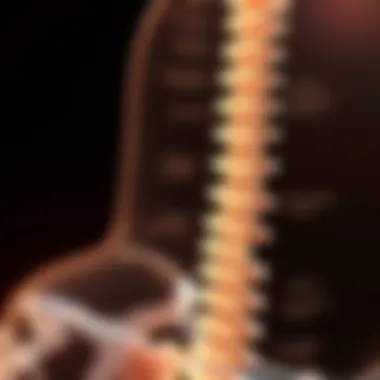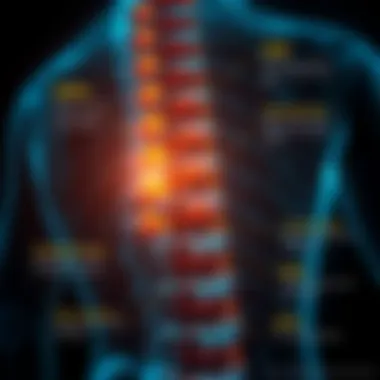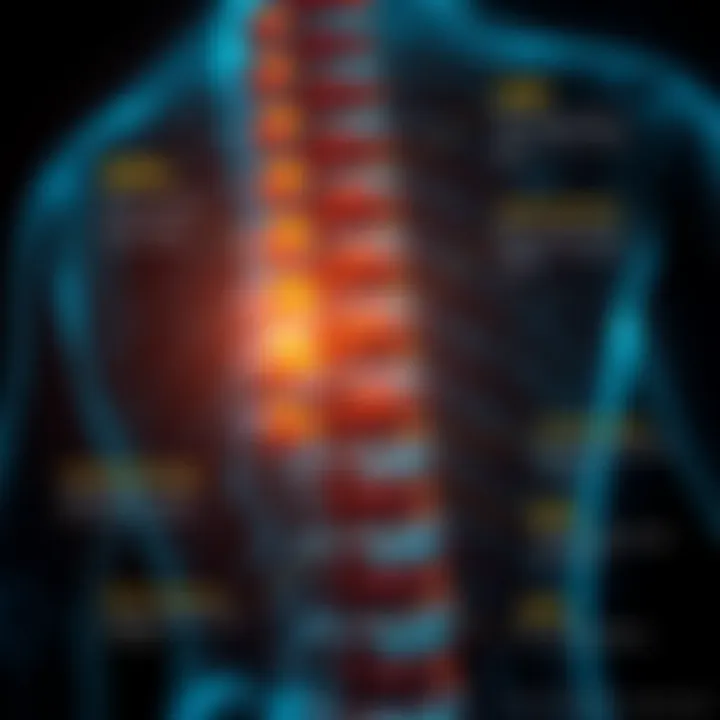Understanding Spinal Degeneration: Mechanisms and Impact


Intro
The spine acts as the backbone of the human body—literally and figuratively—providing not just support but also a pathway for the nervous system. As various factors come into play, the degeneration of spinal structures often leads to significant discomfort and a lower quality of life. Recent studies have uncovered various mechanisms behind spinal degeneration, be it aging, injury, or genetic predisposition. This article embarks on a journey to explore these mechanisms, the methodologies applied in research, and the potential implications of findings in treatment and therapy.
Understanding spinal degeneration can feel like navigating through a maze. It’s not merely about wear and tear; the processes underlying degeneration involve a complex interplay of biological functions. Through this exploration, we aim to shine a light on these vital aspects, offering insights to specialists and curious readers alike.
Research Overview
Summary of Key Findings
The exploration of spinal degeneration has yielded several noteworthy findings:
- Biomechanical changes significantly contribute to the onset of back pain, often observed in various animal models that mimic human conditions.
- Inflammation plays a crucial role in the progression of degenerative diseases, whereby immune responses can further exacerbate the situation.
- Regenerative medicine holds promise, with emerging therapies that target specific degenerative pathways, showcasing potential for recovery and pain relief.
These insights emphasize that spinal health is multi-faceted, requiring an interdisciplinary approach in research and treatment.
Background and Context
Historically, spinal degeneration was often viewed through a narrow lens focusing merely on structural changes. However, as research evolved, it became evident that biological mechanisms like oxidative stress, cellular senescence, and genetic factors are integral parts of the degeneration narrative. The discovery that spinal health is interconnected with lifestyle choices, nutrition, and exercise opened new avenues for intervention strategies.
This evolving understanding necessitates the usage of various experimental models to gain a clearer picture.
Methodology
Experimental Design
The diverse methodologies employed in studying spinal degeneration encompass a variety of experimental designs:
- Animal Models: Different species, such as mice and rats, are utilized to observe the progression of degeneration under controlled conditions.
- In Vitro Studies: Cultured cells are used to isolate specific cellular behaviors linked to degeneration, allowing researchers to manipulate variables.
- Clinical Trials: These assess the efficacy of new treatments and therapies in human subjects, providing invaluable data for future applications.
Data Collection Techniques
Data collection in spinal degeneration studies relies on both qualitative and quantitative techniques:
- Imaging Techniques: MRI and CT scans are invaluable for observing structural changes in the spine.
- Biological Sampling: Tissue and blood samples help in understanding inflammation and other biochemical markers.
- Pain Assessments: Patient-reported measures provide insight into the subjective experience of pain, which is crucial for gauging treatment effectiveness.
By diversifying the methodologies and techniques, researchers can piece together a more comprehensive view of spinal degeneration, enhancing both understanding and treatment strategies.
Prologue to Spinal Degeneration
The study of spinal degeneration encompasses a wide array of biological, social, and technological considerations that are pivotal in understanding how spinal disorders manifest and evolve over time. This topic holds significant importance not only for researchers and healthcare professionals but also for the everyday individual who may be affected by back pain and related ailments. The spine is a complex structure, and its degeneration can lead to a cascade of consequences that impact quality of life, mobility, and overall well-being.
Definition and Importance
Spinal degeneration refers to the gradual decline in the health and functionality of the spine due to various factors, which may include age, injury, and lifestyle choices. It’s crucial to define this concept clearly because understanding the nuances behind spinal degeneration allows us to appreciate the vast implications of its study. For instance, an understanding of this degeneration can help identify at-risk populations and implement preventative measures — a vital step toward mitigating the surge of spine-related disorders seen today.
The importance of this topic extends beyond mere academic interest; it serves as a foundation for innovative treatment strategies. By comprehending the underlying mechanisms of spinal degeneration, researchers can develop targeted therapies that not only relieve pain but also promote spinal health and regeneration. Moreover, it is essential for facilitating discussions around patient education, preventive care options, and the ethical considerations surrounding spinal health treatments.
Prevalence of Spinal Disorders
Spinal disorders are alarmingly common worldwide, affecting millions and often leading to significant disability. According to various health organizations, it is reported that approximately 80% of adults experience back pain at some point in their lives, with numerous factors contributing to this stunning statistic. The reasons for this prevalence are multifaceted — from the rise of sedentary lifestyles exacerbated by technology to the aging population, which naturally predisposes individuals to degenerative conditions.
"In addressing spinal degeneration, we must not only look at treatment but also work towards understanding its origins. Education and research will be our best allies in combating this pervasive issue."
Common spinal disorders include herniated discs, spinal stenosis, and degenerative disc disease, each presenting its own set of challenges and treatment considerations. Importantly, the high prevalence of these conditions has sparked a surge in research into their prevention and management, making the exploration of spinal degeneration models particularly relevant. As we delve deeper into the mechanisms, stages, and implications of spinal degeneration, our aim is to highlight both the challenges faced and the paths forward in addressing these critical health issues.
Understanding Spinal Degeneration
Understanding spinal degeneration is akin to pulling back the curtain on a complex stage play where various factors interact over time, ultimately affecting the human experience of back pain and mobility. This section unpacks the intricacies involved in how spinal degeneration occurs—delving into the specific mechanisms, stages, and broader implications of this condition. Grasping these elements not only enriches our scientific knowledge but also paves the way for better management strategies in clinical practice.
Mechanisms of Degeneration
Cellular changes
Cellular changes mark the initial shifts in spinal health, laying the groundwork for the degeneration that follows. These alterations often begin at the microscopic level, involving shifts in the structure and function of spinal cells, including notochordal cells and chondrocytes. As the years roll on, stressed cells start to produce inflammatory markers, which further exacerbate degeneration.
Key characteristic: These cellular changes can be observed through biomarkers, which provide insight into the ongoing destructive processes. They highlight why recognizing these changes early in patients could lead to timely interventions.
Unique feature and implications: One significant aspect of cellular changes is the potential for reversibility during the initial stages. This factor makes it a valuable focus in research aimed at halting or even reversing degeneration, offering hope for novel therapeutic approaches.


Genetic factors
Genetic factors play a pivotal role in the predisposition to spinal degeneration. Research suggests that certain genetic variations may increase an individual's susceptibility to disorders such as disc degeneration or spinal stenosis. By understanding these variants, practitioners can potentially identify high-risk individuals and tailor preventive measures or treatments accordingly.
Key characteristic: The interaction of genes with environmental factors is a notable feature. This overlap illustrates that genetics alone does not craft the entire story of spinal degeneration; lifestyle and external influences also take center stage.
Advantages and disadvantages: Delving into genetic factors brings both promise and challenges. While genetic screening holds the potential for personalized medicine in spinal health, it can also lead to ethical dilemmas regarding genetic discrimination in healthcare.
Environmental influences
The environment in which an individual lives and works is also a crucial element in spinal degeneration. Factors such as physical activity levels, occupational hazards, and ergonomics can either mitigate or exacerbate degeneration. For instance, someone with a physically demanding job and poor posture may face accelerated degeneration compared to a person in a more ergonomically sound environment.
Key characteristic: The modifiable nature of environmental influences makes them an intriguing focus for research and interventions. Strategies such as improving workplace ergonomics or promoting regular exercise can yield tangible improvements in spinal health outcomes.
Advantages and disadvantages: Recognizing environmental influences allows for actionable strategies. However, these factors can also be challenging to regulate, especially when considering lifestyle choices and socioeconomic constraints.
Stages of Degeneration
Initial changes
Initial changes set the stage for more profound degenerative processes. These may include minor disc dehydration or slight collagen disruptions in spinal tissues. Importantly, misalignments often begin at this stage, leading to discomfort or mild pain that may go unnoticed.
Key characteristic: It is critical to identify these changes early. Detection can often prevent progression, underscoring the importance of routine check-ups for at-risk populations.
Unique aspect: The initial changes present a window of opportunity for intervention, as early-stage patients may respond positively to conservative treatment modalities.
Intermediate stages
As degeneration progresses into intermediate stages, the symptoms typically become more pronounced. Patients may experience increased pain, reduced mobility, and cognitive effects like anxiety or depression stemming from chronic discomfort.
Key characteristic: At this point, structural changes in the spine become visible on imaging studies like MRIs, allowing medical professionals to assess the severity of degeneration accurately.
Advantages and disadvantages: These stages serve as a double-edged sword. While they offer ample information for treatment planning, they also signal an increased likelihood of requiring invasive procedures if conservative approaches fail.
Severe degeneration
Severe degeneration marks the end of the line in many cases and often results in significant impairment in daily activities. Patients may deal with debilitating pain and may require surgical interventions, such as spinal fusion or decompression surgeries.
Key characteristic: The extent of degeneration at this stage often complicates recovery efforts, making it an essential focus of clinical studies aimed at lessening surgical need.
Unique aspect: Although severe degeneration typically indicates a poor prognosis, it also stimulates dialogue about the necessity of proactive health measures and research into regenerative treatments.
Models of Spinal Degeneration
The exploration of spinal degeneration is incomplete without understanding the models that researchers employ to replicate and study this complex phenomenon. Models of spinal degeneration serve as vital tools in both basic and applied research, enabling scientists to explore the underlying mechanisms of degeneration as well as potential therapeutic interventions. The importance of these models cannot be overstated; they offer insights into the pathophysiological changes in the spine while also paving the way for advancements in treatment strategies.
Animal Models in Research
Rodent models
Rodent models, specifically using mice and rats, are some of the most prevalent in spinal degeneration research. One of the reasons for their popularity lies in their biological and genetic similarities to humans, which facilitate translational research. These small mammals allow researchers to manipulate various factors like diet, genetic predispositions, and environmental stressors.
A key characteristic of rodent models is their relatively short lifespan, which enables the observation of both early and advanced stages of degeneration within a practical time frame. This makes them beneficial for studies looking at the effects of interventions over time. Unique features such as easy genetic manipulation allow the study of specific genes related to spinal health. However, it is important to note that while rodent models can provide invaluable information, they sometimes fail to fully replicate human spinal conditions due to anatomical and physiological differences.
Canine models
Canine models present another angle in the study of spinal degeneration. Dogs naturally suffer from many of the same degenerative spinal conditions seen in humans, making them a suitable choice for comparative research. Notably, their larger size can provide insights that are more challenging to gather from smaller rodent models. This translates to a more realistic biomodel that can better mimic the human spinal architecture.
What sets canine models apart is their natural history of disease. Dogs exhibit similar degenerative changes that we see in aging humans, making them a valuable resource for studying the progression of spinal disorders. However, the disadvantages include ethical considerations regarding the treatment and care of these animals in research settings, along with higher costs associated with their maintenance.
Non-human primates
Non-human primates are often considered the gold standard in biomedical research due to their close evolutionary relationship with humans. Their spinal anatomy and functions are more comparable, allowing for deeper insights into the shared pathophysiology of spinal degeneration. Studies utilizing non-human primates can lead to an enhanced understanding of the cognitive and motor implications of spinal disorders.
One critical aspect is that these models help in assessing both the mechanical and neurological changes brought on by degeneration. However, the extensive ethical implications and costs associated with using non-human primates often limit their widespread application in research. While they provide a high degree of translatability to humans, researchers must balance these benefits against the ethical considerations of using such intelligent and social animals in experimental settings.
In Vitro Models
Cell cultures
Cell cultures are a cornerstone of research in spinal degeneration. They are used to study cellular responses to various stimuli, such as inflammation or mechanical stress, in a controlled environment. The primary feature is their ability to isolate specific cell types, such as intervertebral disc cells or neurons, allowing for focused investigations.


The advantages of cell cultures lie in their simplicity and flexibility. Researchers can manipulate the environment- factors like oxygen levels or nutrient availability to mimic the conditions leading to degeneration. This provides insights that are not achievable in whole organism studies. Nevertheless, a significant drawback is the lack of complexity since cell cultures do not replicate the intricate interactions found in living organisms.
Organotypic cultures
Organotypic cultures bridge a gap between cell cultures and whole animals. These cultures retain aspects of the tissue's architecture and cellular interactions, making them crucial for studying the complex responses observed in spinal degeneration. They help researchers investigate disease mechanisms while allowing for spatial organization similar to that found in vivo.
These cultures can simulate more accurately how spinal tissues behave during degenerative processes compared to standard cell cultures. However, their complexity can be a double-edged sword, requiring more meticulous technique and care to maintain the tissue's viability and function over time.
Computational Models
Simulation techniques
Simulation techniques have emerged as a powerful tool in understanding spinal degeneration. By creating virtual models based on existing biological data, researchers can examine how changes at the cellular or molecular level may impact larger systems, such as the spine. The key characteristic here is the ability to run numerous scenarios quickly and cost-effectively, unlike physical experiments.
One unique feature of simulation techniques is their capacity for predictive analysis. Researchers can anticipate disease progression, test potential interventions, and examine structural changes in a way that would be cumbersome in physical models. However, the limitations mainly stem from the assumptions and simplifications built into these models, which may not always reflect real-life complexities.
Predictive modeling
Predictive modeling in spinal degeneration relies on leveraging data to forecast outcomes based on various parameters. This method combines elements of both statistical analysis and computational algorithms to evaluate how different factors might influence degeneration and pain. Its appeal lies in its applicability to personalize treatment options tailored to individual patients.
The unique feature here is the dynamic nature of predictive models, which can be updated as new data becomes available, keeping them relevant and accurate. On the flip side, these models depend heavily on the quality and scope of the underlying data. If the data is limited or flawed, so too will be the predictive outcomes.
Understanding these models forms the backbone of translational research, shedding light on the complexities of spinal degeneration and offering pathways toward innovative therapeutic strategies.
Ethical Considerations in Spinal Research
Ethical considerations in spinal research are of paramount importance, especially in the context of understanding and treating spinal degeneration. This section sheds light on the ethical principles that guide research practices, ensuring that the welfare of all living subjects is prioritized while also pushing the boundaries of knowledge and innovation in this critical area of health.
Animal Welfare
When it comes to spinal research, animal models are often utilized to mimic the complexities of human spinal degeneration. However, this raises significant ethical questions. Researchers have a responsibility to ensure that their procedures minimize discomfort and suffering among these animals.
- Humane Treatment: Following guidelines that outline the humane care and use of animals can help maintain ethical standards. These guidelines often emphasize minimizing pain through proper anesthetics and conducting only those experiments that are absolutely necessary.
- Alternatives to Animal Research: The 3Rs principle—Replacement, Reduction, and Refinement—serves as a compass for researchers. This means looking for alternative methods (like in vitro studies) when possible, reducing the number of animals used without compromising the scientific integrity of the research, and refining procedures to enhance animal welfare.
- Informed Consent and Review: Larger institutions often have an ethical review board that assesses research proposals. The role of these boards is to scrutinize proposed experiments to ensure they adhere to ethical standards that protect animal welfare.
"The humane treatment of animals in research not only aligns with moral principles but also enhances the quality of scientific findings, as stress can alter biological responses."
Regulatory Frameworks
In order to safeguard ethical practices in spinal research, various regulatory frameworks exist at both national and international levels. These regulations are paramount to maintaining high ethical standards and ensuring accountability among researchers.
- Federal Regulations: In the United States, the Animal Welfare Act mandates humane treatment of laboratory animals and sets provisions for their care, housing, and use in research. Such regulations are designed to protect the rights and welfare of research animals.
- Institutional Animal Care and Use Committees (IACUC): These committees review research proposals involving animals, ensuring compliance with ethical guidelines and regulatory mandates. They assess whether the benefits of the research justify the use of animals and how well researchers plan to mitigate suffering.
- International Guidelines: Various international bodies, such as the World Health Organization (WHO) and the American Psychological Association (APA), provide guidelines that researchers should follow to uphold ethical standards in research. These guidelines often provide recommendations, best practices, and frameworks for ethical evaluation and oversight.
Overall, the ethical landscape in spinal research is both complex and necessary. By establishing a framework for humane treatment and compliance with regulatory requirements, researchers can pursue their goals while ensuring the dignity of all subjects involved in their studies. This ethical foundation not only tightens the connection between research and practice but also fosters trust in scientific advancement related to spinal health.
Therapeutic Implications
Addressing spinal degeneration effectively is crucial for enhancing the quality of life for affected individuals. The combination of multiple therapeutic approaches sheds light on the complexity of managing this condition. Therapeutic implications encompass a range of strategies aimed at alleviating pain, restoring function, and improving overall health outcomes for patients. Each method has its unique characteristics, benefits, and considerations, which are essential to understand in the broader narrative of spinal health.
Current Treatment Strategies
Physical therapy
Physical therapy plays a pivotal role in rehabilitation for those suffering from spinal degeneration. Its key characteristic lies in its non-invasive nature, focusing on muscle strengthening, flexibility, and functional movement. Many patients find physical therapy appealing due to its customized approaches, allowing treatment to address individual needs.
One noteworthy aspect of physical therapy is the incorporation of specialized exercises tailored to build core stability, which is vital for spinal support. The advantages of these therapeutic exercises include enhanced mobility and reduced pain through gradual improvement. However, there's a downside; achieving significant results may require consistent commitment over months, which can be daunting for some people.
Pharmacologic treatments
Pharmacologic treatments refer to medication strategies aimed at managing symptoms associated with spinal degeneration. Nonsteroidal anti-inflammatory drugs (NSAIDs), for example, are commonly recommended as initial treatments for pain relief. The chief attraction of pharmacologic therapies is their immediate effect in reducing discomfort and inflammation, enabling individuals to resume daily activities more quickly.
On another note, while medications can offer quick relief, they may introduce adverse effects, such as gastrointestinal irritation or dependency. Long-term reliance on pharmacologic treatments might be problematic, steering both medical professionals and patients towards complementary strategies to ensure sustained improvement and safety.
Surgical options
When conservative treatments fail to yield sufficient relief, surgical options may come into play. Surgical intervention often involves procedures aimed at decompressing nerves or stabilizing the spine, thus addressing the structural issues of degeneration. This approach can be seen as a last resort and is often recommended when the condition severely impacts a patient's quality of life and mobility.
A significant advantage of surgical options is the potential for lasting impact, with many patients reporting durable improvements in function and pain relief. However, surgical options are typically more invasive and carry risks, including the possibility of complications such as infections or nerve damage. It also requires a longer recovery period, during which patient adherence to rehabilitation protocols becomes crucial.
Regenerative Medicine Approaches


As research evolves, regenerative medicine has emerged as a promising frontier in treating spinal degeneration. This approach encompasses therapies aimed at repairing or regenerating damaged tissues to restore spinal health and function.
Stem cell therapy
Stem cell therapy stands out as a compelling regenerative approach that seeks to promote tissue repair. It relies on the unique abilities of stem cells to differentiate into various cell types related to spinal health. One key characteristic of this method is its potential to not only alleviate symptoms but also tackle the underlying causes of degeneration by regenerating damaged tissues.
This therapy is often perceived as a beneficial option since it may circumvent some drawbacks of conventional treatments. However, the use of stem cells is still under active investigation, leading to concerns about standardization, potential complications, and the need for further research to assess long-term safety and efficacy.
Tissue engineering
Tissue engineering complements stem cell therapy, focusing on creating biological substitutes that repair or replace damaged spinal structures. This method uniquely combines scaffolds, cells, and bioactive factors to replicate the mechanical and biological properties of natural tissues. Its rising popularity in the field stems from its potential to provide more sustainable solutions compared to traditional approaches.
Nevertheless, tissue engineering faces its own challenges, including the complexity of mimicking natural tissue behavior and the need for extensive testing to ensure biocompatibility. Additionally, integration into the body remains a significant area of concern, as improper integration can hinder the treatment's success.
In summary, understanding the diverse therapeutic implications in spinal degeneration broadens the horizon for effective management strategies. As treatment modalities evolve, keeping an eye on the balance between immediate relief and sustainable health becomes paramount.
Challenges in Spinal Degeneration Research
Understanding spinal degeneration is no small feat, as it’s far more complicated than one might think. In the quest to unravel the complexities of spinal issues, researchers face a myriad of challenges. These hurdles not only hinder progress but also have far-reaching implications for treatment and patient outcomes. Examining these challenges helps illuminate the path forward in spinal degeneration research, highlighting areas ripe for innovation and discovery.
Limitations of Current Models
Translatability to humans
One of the primary issues with spinal degeneration research is the translatability of animal models to human conditions. While animal tests provide critical insights, they don’t always capture the full spectrum of human responses due to biological differences. For instance, the way degeneration unfolds in a mouse model might vastly differ from human experiences. This limitation makes it hard to predict how findings in animals will perform in clinical settings.
A key characteristic of translatability is its crucial role in bridging gaps between laboratory findings and actual patient treatment. While animal models like rodents are widely utilized, understanding the shortcomings of these models is just as vital as recognizing their contributions. They can offer a glimpse into mechanisms of degeneration, but translating these insights to humans requires caution and often, multiple trials.
The unique feature here is the reliance on human-relevant endpoints. While certain results might suggest one pathway functions positively in animals, it doesn't guarantee the same outcome in humans. This limitation can lead researchers down unproductive paths, wasting resources while potentially delaying groundbreaking treatments.
Variables affecting outcomes
Another significant consideration in spinal research is the multitude of variables that can affect the outcomes. These variables can range from genetic background to environmental factors. Every individual carries a unique genetic makeup, influencing how spinal degeneration occurs and progresses. Similarly, lifestyle choices—such as diet and exercise—play a pivotal role in spinal health.
The characteristic here that stands out is the inherent variability in both patient populations and research subjects. This variability can lead to inconsistencies in results, often complicating the interpretation of data across different studies. It raises questions about the validity of research outcomes and how applicable they are to the general population.
When considering unique features of outcome variables, one sees that they can provide a wealth of data. However, the challenge lies in controlling for these variables during research, as overlooking them can skew results and mislead conclusions. Recognizing these factors is crucial for refining models and enhancing the reliability of findings.
Future Directions in Research
Looking ahead, the path to innovation in spinal degeneration research navigates through interdisciplinary collaboration and technological advancements. The convergence of various fields can bolster understanding and foster groundbreaking treatments that are more aligned with human physiology.
Integration of interdisciplinary approaches
Integrating interdisciplinary approaches is becoming increasingly crucial in spinal research. Collaboration between biologists, engineers, and clinicians brings fresh perspectives, improving the understanding of spinal degeneration. This melting pot of ideas can lead to innovative solutions that a singular discipline might overlook.
The key aspect of this integration is its potential to develop holistic models of spinal health. Traditional disciplines might focus narrowly on one aspect, but interdisciplinary work can encompass various facets of spinal degeneration, ultimately yielding more comprehensive insights. This is a beneficial choice because it fosters creativity and broadens the scope of potential solutions for complex spinal disorders.
A unique feature of this integration is its capacity to merge high-tech tools with biological research. From engineering to create better imaging technologies to biochemistry for innovative drug development, collaboration is a shotgun approach to tackling spinal degeneration. It enriches the research landscape while enhancing the power of each discipline involved.
Advancements in technology
The rapid advancements in technology are reshaping spinal degeneration research. With tools like machine learning and advanced imaging techniques, researchers can now analyze vast datasets with an unprecedented level of detail. These technologies facilitate deeper insights into the mechanisms of spinal degeneration, propelling the field forward.
A significant aspect of these advancements is automation, which streamlines research processes. By removing some of the more tedious tasks from the picture, researchers can focus on interpreting data and developing creative solutions. This can lead to faster identification of potential treatments and a more dynamic research landscape.
However, it’s essential to balance technological advancements with the fundamental biology of the spine. While tech can enhance our understanding, over-reliance can lead to disregarding the nuances of biological systems. It’s crucial that technology serves as a tool rather than a replacement for foundational research methodologies.
Ending
Understanding spinal degeneration is not merely an academic endeavor; it has profound implications for diagnosis, treatment, and ultimately the quality of life for millions. This article has traversed the intricate landscape of spinal degeneration mechanisms, research methodologies, and therapeutic outcomes, highlighting the multifaceted nature of this condition.
Summary of Findings
To encapsulate the discussion laid forth:
- Mechanisms of Degeneration: We explored various biological processes, from cellular changes caused by aging and genetic predispositions to environmental factors that play a crucial role in advancing the degeneration of spinal structures.
- Research Models: Different experimental models, including animal studies and computational simulations, were evaluated for their effectiveness in researching spinal degeneration. Each model comes with its strengths and limitations, raising important considerations regarding their applicability in clinical settings.
- Therapeutic Innovations: Several treatment strategies were examined, focusing on physical therapy, pharmacologic solutions, and cutting-edge regenerative approaches like stem cell therapy and tissue engineering. These avenues open doors for future therapies that could significantly alter patient outcomes.
The findings drive home the message that successful management of spinal disorders relies on a comprehensive understanding of underlying processes and the ongoing refinement of research approaches.
Call for Innovation
As we stand at a crossroads of knowledge and technology, the urgency for innovation in spinal degeneration research cannot be overstated. Several key areas warrant attention:
- Interdisciplinary Approaches: Merging insights from various fields, such as biomechanics, molecular biology, and advanced imaging techniques, can catalyze new therapies. It is imperative that professionals across these domains collaborate to foster advancements.
- Patient-Centric Research: There’s a pressing need for strategies that incorporate patient experiences and outcomes into research frameworks. This would ensure that the advancements in treatment are not just technically sound but also align with patient needs and expectations.
- New Technologies: Embracing cutting-edge technologies like artificial intelligence and machine learning can enhance predictive modeling for spinal disorders, leading to personalized medicine approaches.
Innovation is the bedrock of progress. As we explore and understand the complexities of spinal degeneration, it is crucial to remain open to novel ideas and methodologies.







